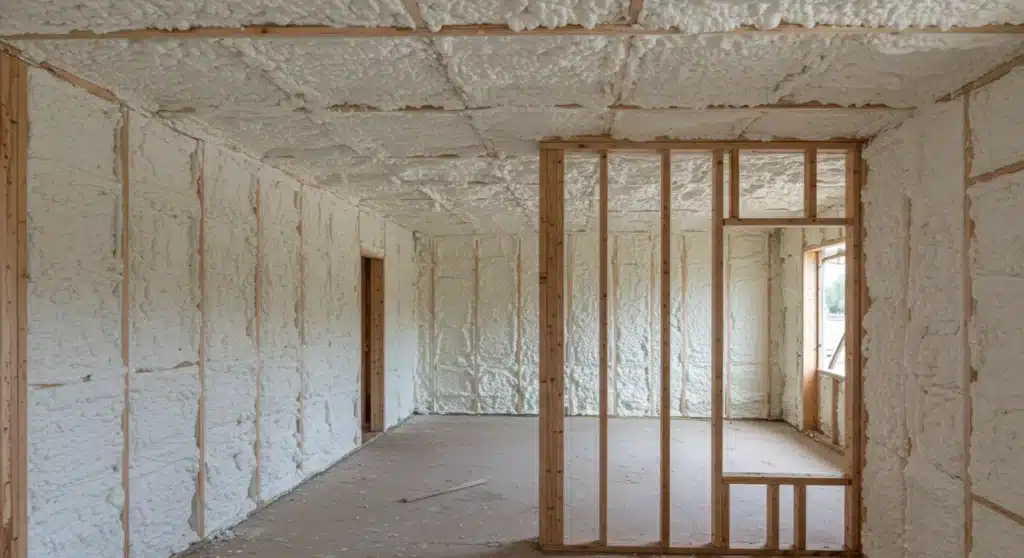Proper insulation stabilizes indoor temperatures, reduces strain on HVAC systems, and prevents moisture buildup during extreme weather. In heatwaves, it blocks external heat from entering. In freezing temperatures, it retains indoor warmth. The right insulation slows thermal transfer through the building envelope, protecting structural materials and maintaining occupant comfort.
Without sufficient insulation, homes experience temperature swings, condensation buildup, and energy waste. In areas with frequent weather extremes, this leads to faster wear on systems and surfaces. This article provides in-depth guidance, technical data, and practical insights based on real-world insulation practices.
Makeover Insulation draws from direct field experience across diverse climates, allowing each recommendation to reflect hands-on expertise with material performance and installation outcomes.
Core Functions of Insulation in Extreme Conditions
Thermal Regulation and HVAC Load Reduction
- Prevents overheating during high-temperature events
- Retains warmth during deep cold spells
- Reduces HVAC cycling, lowering system fatigue and maintenance
Moisture and Condensation Management
- Minimizes condensation risk during rapid outdoor temperature shifts
- Helps protect internal wall cavities from mold and rot
Material Durability and Building Envelope Protection
- Reduces expansion/contraction stress on framing and drywall
- Improves longevity of building materials exposed to thermal fluctuations
Comparative Performance of Insulation Types
| Insulation Type | Best for Heat Resistance | Best for Cold Retention | Air Sealing Ability | Installation Complexity | Moisture Control |
|---|---|---|---|---|---|
| Spray Foam (Closed Cell) | High | High | Excellent | Moderate to High | High |
| Blown-In Cellulose | Moderate | High | Moderate | Low to Moderate | Moderate |
| Fiberglass Batts | Low to Moderate | Moderate | Low | Low | Low |
| Blown-In Fiberglass | Moderate | Moderate | Moderate | Moderate | Low |
| Rigid Foam Board | High | High | Good | High | Moderate to High |
Technical Specifications
| Material | R-Value per Inch | Water Resistance | Air Barrier Rating | Lifespan (avg.) |
|---|---|---|---|---|
| Closed Cell Spray Foam | 6.0 – 7.5 | High | Excellent | 25–30 years |
| Cellulose (Blown-In) | 3.2 – 3.8 | Moderate | Moderate | 20–30 years |
| Fiberglass (Batt) | 2.9 – 3.8 | Low | Poor | 10–25 years |
| Rigid Foam Board | 4.5 – 6.5 | High | Good | 30–40 years |
Climate-Specific Insights
Southeastern US (Hot, Humid Summers / Occasional Freezing Winters)
- Closed-cell spray foam works best in attics and crawl spaces due to air sealing and moisture control.
- Blown-in cellulose performs well in wall cavities where retrofitting is needed.
Mountain Regions (Cold Winters, Wide Temp Swings)
- Rigid foam or spray foam provides consistent insulation during large day-night temperature shifts.
- Air sealing must accompany insulation to prevent ice damming and moisture intrusion.
Coastal Areas (Humidity and Salt Exposure)
- Use materials with mold-resistant properties and minimal air permeability.
- Avoid fiberglass batts in crawl spaces and walls exposed to dampness.
Bonus Tips Based on Field Experience
- Always pair insulation with air sealing for measurable energy savings and moisture control.
- Avoid compressing fiberglass batts—this reduces R-value significantly.
- Use vapor retarders in extreme cold zones to prevent interior moisture from condensing inside wall assemblies.

Things to Consider Before Making a Decision
- Building Age and Structure Type: Older homes may have insulation gaps or non-standard framing.
- Local Climate Extremes: Choose insulation that addresses your region’s most frequent weather threats.
- Moisture History: Prior water damage requires inspection before adding insulation.
- HVAC Compatibility: Oversized or undersized systems behave differently depending on insulation levels.
- Budget vs. Long-Term Savings: Upfront investment in spray foam or rigid foam often reduces long-term utility costs.
Makeover Insulation Services for Extreme Weather Protection
- Spray Foam Insulation: Closed-cell spray foam offers high R-value, air sealing, and moisture resistance in one application.
- Blown-In Insulation: Efficient coverage in attics and wall cavities, especially for retrofits or upgrades.
- Air Sealing: Seals cracks and penetrations, working with insulation to block heat and moisture intrusion.
- Insulation Removal: Safe removal of compromised or outdated materials before replacement.
Common Questions Before Choosing Insulation
How do I know if my current insulation is failing?
Drafts, high utility bills, uneven temperatures, or visible settling signal underperforming insulation.
Can I mix insulation types in one home?
Yes. Many homes benefit from hybrid systems, like spray foam in crawl spaces and cellulose in walls.
Does higher R-value always mean better performance?
Only if air sealing and moisture control are also addressed. R-value alone doesn’t account for airflow or humidity.
Is insulation a one-time investment?
It depends on the material. Spray foam and rigid foam typically last longer than batts or cellulose.
Get Expert Insulation Guidance
For questions about insulation types, installation methods, or choosing the right product for your home and climate, contact:
Makeover Insulation Phone: (470) 664-5300 Email: sales@makeoverinsulation.com
Every consultation is based on building science, local climate knowledge, and real installation experience.
Frequently Asked Questions About Long-Term Use
What maintenance is needed after insulation installation?
Check for air leaks, moisture signs, and HVAC efficiency annually. Insulation itself is low-maintenance.
Can pests damage insulation?
Yes. Cellulose and fiberglass are more prone to nesting. Use treated materials where needed.
How does insulation affect indoor air quality?
Properly installed insulation reduces dust and allergens by minimizing air exchange with unconditioned spaces.
Will insulation help with soundproofing?
Yes, dense materials like cellulose and spray foam can reduce airborne noise transfer between rooms and floors.
Is DIY insulation a good idea for extreme weather zones?
Not recommended. Improper installation leads to thermal bridging, moisture traps, and safety issues.




